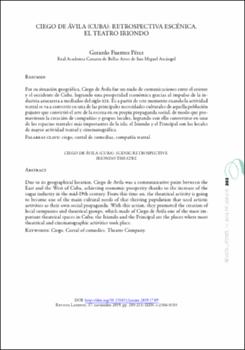Ciego de Ávila (Cuba): retrospectiva escénica. El Teatro Iriondo
Author
Fuentes Pérez, Gerardo F.Date
2019Abstract
Por su situación geográfica, Ciego de Ávila fue un nudo de comunicaciones entre el oriente
y el occidente de Cuba, logrando una prosperidad económica gracias al impulso de la industria
azucarera a mediados del siglo xix. Es a partir de este momento cuando la actividad
teatral se va a convertir en una de las principales necesidades culturales de aquella población
pujante que convirtió el arte de la escena en su propia propaganda social, de modo que promovieron
la creación de compañías y grupos locales, logrando con ello convertirse en uno
de los espacios teatrales más importantes de la isla; el Iriondo y el Principal son los locales
de mayor actividad teatral y cinematográfica. Due to its geographical location, Ciego de Avila was a communicative point between the
East and the West of Cuba, achieving economic prosperity thanks to the increase of the
sugar industry in the mid-19th century. From this time on, the theatrical activity is going
to become one of the main cultural needs of that thriving population that used artistic
activities as their own social propaganda. With this action, they promoted the creation of
local companies and theatrical groups, which made of Ciego de Ávila one of the most important
theatrical spaces in Cuba; the Iriondo and the Principal are the places where most
theatrical and cinematographic activities took place.





